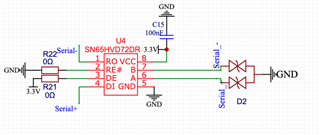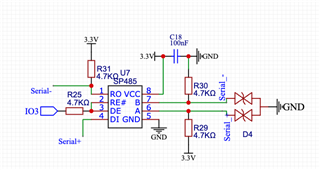Other Parts Discussed in Thread: MAX3221, SN74AUP2G17, THVD1426, THVD1406
I have an rs232 communication line that I have been communicating directly to an esp32. Recently I decided to include a SN65HVD72DR for a little added protection. Since I have been communicating directly for months, I decided to leave rx and tx on all the time by holding the re low and the de high. I thought this would work. However, now that I have added this transceiver to my board I have no serial comms. Am I using this incorrectly?
Serial-/ Serial+ ties to my esp32
Serial_-/Serial_+ ties to the device I am interfacing with.


